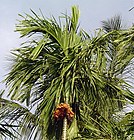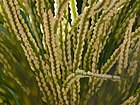Note: This is a project under development. The articles on this wiki are just being initiated and broadly incomplete. You can Help creating new pages.
Difference between revisions of "Areca catechu - Pooga"
(→References) |
(→List of Ayurvedic medicine in which the herb is used) |
||
| (15 intermediate revisions by the same user not shown) | |||
| Line 1: | Line 1: | ||
| − | |||
[[File:Arcanut @ Betelnut.JPG|thumb|right]] | [[File:Arcanut @ Betelnut.JPG|thumb|right]] | ||
'''Pooga''' consists of dried ripe seed of Areca catechu Linn. (Fam. Palmae), a graceful, slender, stemmed, perennial palm, trunk reaching a height of about 25 m cultivated in the coastal regions of Southern India, Bengal and Assam upto an altitude of 1000 m.<ref name="AYURVEDIC PHARMACOPOEIA OF INDIA"/> | '''Pooga''' consists of dried ripe seed of Areca catechu Linn. (Fam. Palmae), a graceful, slender, stemmed, perennial palm, trunk reaching a height of about 25 m cultivated in the coastal regions of Southern India, Bengal and Assam upto an altitude of 1000 m.<ref name="AYURVEDIC PHARMACOPOEIA OF INDIA"/> | ||
==Uses== | ==Uses== | ||
| − | {{Uses|Scizophrenia}}, {{Uses|Arecoline}}, {{Uses|Tapeworms}}, {{Uses|Anaemia}}, {{Uses|Fits}}, {{Uses|Leucoderma}}, {{Uses|Nasal ulcers}}, {{Uses|Leprosy}}, {{Uses|Obesity}}, {{Uses|Dysentery}}, {{Uses|Malaria}}, {{Uses|Constipation}}, {{Uses|Oedema}} | + | {{Uses|Scizophrenia}}, {{Uses|Arecoline}}, {{Uses|Tapeworms}}, {{Uses|Anaemia}}, {{Uses|Fits}}, {{Uses|Leucoderma}}, {{Uses|Nasal ulcers}}, {{Uses|Leprosy}}, {{Uses|Obesity}}, {{Uses|Dysentery}}, {{Uses|Malaria}}, {{Uses|Constipation}}, {{Uses|Oedema}}<ref name="Karnataka Medicinal Plants"/> |
==Parts Used== | ==Parts Used== | ||
| − | {{Parts Used|Seed}}, {{Parts Used|Young leaf}} | + | {{Parts Used|Seed}}, {{Parts Used|Young leaf}}<ref name="Karnataka Medicinal Plants"/> |
==Chemical Composition== | ==Chemical Composition== | ||
| Line 12: | Line 11: | ||
==Common names== | ==Common names== | ||
| − | {{Common names|sa=Kramuka, Ghonaa|en=Areca nut, Betle nut|gu=Supari, Chr alia|hi=Supari, Chr alia|kn=Adike|ks=Supari, Spari|ml=Adakku, Pakku|mr=Supari, Pophal|pa=Supari, Spari|ta=Paka chekka, Vakka|te=Paka chekka, Vakka|en=Areca nut}} | + | {{Common names|sa=Kramuka, Ghonaa|en=Areca nut, Betle nut|gu=Supari, Chr alia|hi=Supari, Chr alia|kn=Adike|ks=Supari, Spari|ml=Adakku, Pakku|mr=Supari, Pophal|pa=Supari, Spari|ta=Paka chekka, Vakka|te=Paka chekka, Vakka|en=Areca nut}}<ref name="Karnataka Medicinal Plants"/> |
==Properties== | ==Properties== | ||
| Line 45: | Line 44: | ||
==List of Ayurvedic medicine in which the herb is used== | ==List of Ayurvedic medicine in which the herb is used== | ||
| + | [[Kumāryāsava]], [[Dashamoolarishta]], [[Pippalyadyasava]], [[Bhimashakti Rasaayana]], [[Lodrasava]]<ref name="Karnataka Medicinal Plants"/> | ||
==Where to get the saplings== | ==Where to get the saplings== | ||
| Line 69: | Line 69: | ||
==References== | ==References== | ||
<references> | <references> | ||
| − | <ref name="chemical composition"> | + | <ref name="chemical composition">THE AYURVEDIC PHARMACOPOEIA OF INDIA, PART-I, VOLUME-1, page no 125.</ref> |
<ref name="Leaf">[Morphology]</ref> | <ref name="Leaf">[Morphology]</ref> | ||
| − | <ref name="How to plant/cultivate"> | + | <ref name="How to plant/cultivate">Useful tropical plants</ref> |
<ref name="AYURVEDIC PHARMACOPOEIA OF INDIA">THE AYURVEDIC PHARMACOPOEIA OF INDIA, PART-I, VOLUME-1, page no 125.</ref> | <ref name="AYURVEDIC PHARMACOPOEIA OF INDIA">THE AYURVEDIC PHARMACOPOEIA OF INDIA, PART-I, VOLUME-1, page no 125.</ref> | ||
| − | <ref name=" | + | <ref name="Karnataka Medicinal Plants">"Karnataka Medicinal Plants Volume - 3" by Dr.M. R. Gurudeva, Page No.39, 40 and 48, Published by Divyachandra Prakashana, #45, Paapannana Tota, 1st Main road, Basaveshwara Nagara, Bengaluru.</ref> |
| − | + | </references> | |
==External Links== | ==External Links== | ||
| − | * [http://www.ayurveda.hu/api/API-Vol-1.pdf | + | * [http://www.ayurveda.hu/api/API-Vol-1.pdf The Ayurvedic Pharmacopeia] |
| − | * [ ] | + | * [https://scialert.net/fulltext/?doi=rjmp.2011.145.152 Areca catechu on Science alert.com] |
| − | + | ||
[[Category:Ayurvedic Medicine]] | [[Category:Ayurvedic Medicine]] | ||
[[Category:Pages without herbs images]] | [[Category:Pages without herbs images]] | ||
Latest revision as of 12:18, 13 August 2023
Pooga consists of dried ripe seed of Areca catechu Linn. (Fam. Palmae), a graceful, slender, stemmed, perennial palm, trunk reaching a height of about 25 m cultivated in the coastal regions of Southern India, Bengal and Assam upto an altitude of 1000 m.[1]
Contents
- 1 Uses
- 2 Parts Used
- 3 Chemical Composition
- 4 Common names
- 5 Properties
- 6 Habit
- 7 Identification
- 8 List of Ayurvedic medicine in which the herb is used
- 9 Where to get the saplings
- 10 Mode of Propagation
- 11 How to plant/cultivate
- 12 Commonly seen growing in areas
- 13 Photo Gallery
- 14 References
- 15 External Links
Uses
Scizophrenia, Arecoline, Tapeworms, Anaemia, Fits, Leucoderma, Nasal ulcers, Leprosy, Obesity, Dysentery, Malaria, Constipation, Oedema[2]
Parts Used
Chemical Composition
It contains Alkaloid (arecoline) tannins and fats etc.[3]
Common names
| Language | Common name |
|---|---|
| Kannada | Adike |
| Hindi | Supari, Chr alia |
| Malayalam | Adakku, Pakku |
| Tamil | Paka chekka, Vakka |
| Telugu | Paka chekka, Vakka |
| Marathi | Supari, Pophal |
| Gujarathi | Supari, Chr alia |
| Punjabi | Supari, Spari |
| Kashmiri | Supari, Spari |
| Sanskrit | Kramuka, Ghonaa |
| English | Areca nut |
Properties
Reference: Dravya - Substance, Rasa - Taste, Guna - Qualities, Veerya - Potency, Vipaka - Post-digesion effect, Karma - Pharmacological activity, Prabhava - Therepeutics.
Dravya
Rasa
Kashaya
Guna
Guru, Ruksha
Veerya
Sheeta
Vipaka
Katu (Pungent)
Karma
Prabhava, Mohakrit, Deepana, Kaphapittajit, Kledanaashana, Malabhedi, Mukhshodhana
Prabhava
Habit
Identification
Leaf
| Kind | Shape | Feature |
|---|---|---|
Flower
| Type | Size | Color and composition | Stamen | More information |
|---|---|---|---|---|
| Flowering season is December to April |
Fruit
| Type | Size | Mass | Appearance | Seeds | More information |
|---|---|---|---|---|---|
| Fruiting season is December to April |
Other features
List of Ayurvedic medicine in which the herb is used
Kumāryāsava, Dashamoolarishta, Pippalyadyasava, Bhimashakti Rasaayana, Lodrasava[2]
Where to get the saplings
Mode of Propagation
How to plant/cultivate
Plants succeed in moist tropical climates where temperatures never fall below 10°c, the average annual rainfall is 1,500mm or more and the driest month has 25mm or more rain.Prefers a mean annual rainfall in the range 1,500 - 5,000mm, evenly distributed through the year.[5]
Commonly seen growing in areas
Tropical area, High rainfall forests.
Photo Gallery
References
- ↑ THE AYURVEDIC PHARMACOPOEIA OF INDIA, PART-I, VOLUME-1, page no 125.
- ↑ 2.0 2.1 2.2 2.3 "Karnataka Medicinal Plants Volume - 3" by Dr.M. R. Gurudeva, Page No.39, 40 and 48, Published by Divyachandra Prakashana, #45, Paapannana Tota, 1st Main road, Basaveshwara Nagara, Bengaluru.
- ↑ THE AYURVEDIC PHARMACOPOEIA OF INDIA, PART-I, VOLUME-1, page no 125.
- ↑ [Morphology]
- ↑ Useful tropical plants
External Links
- Pages using duplicate arguments in template calls
- Ayurvedic Herbs known to be helpful to treat Scizophrenia
- Ayurvedic Herbs known to be helpful to treat Arecoline
- Ayurvedic Herbs known to be helpful to treat Tapeworms
- Ayurvedic Herbs known to be helpful to treat Anaemia
- Ayurvedic Herbs known to be helpful to treat Fits
- Ayurvedic Herbs known to be helpful to treat Leucoderma
- Ayurvedic Herbs known to be helpful to treat Nasal ulcers
- Ayurvedic Herbs known to be helpful to treat Leprosy
- Ayurvedic Herbs known to be helpful to treat Obesity
- Ayurvedic Herbs known to be helpful to treat Dysentery
- Ayurvedic Herbs known to be helpful to treat Malaria
- Ayurvedic Herbs known to be helpful to treat Constipation
- Ayurvedic Herbs known to be helpful to treat Oedema
- Herbs with Seed used in medicine
- Herbs with Young leaf used in medicine
- Herbs with common name in Kannada
- Herbs with common name in Hindi
- Herbs with common name in Malayalam
- Herbs with common name in Tamil
- Herbs with common name in Telugu
- Herbs with common name in Marathi
- Herbs with common name in Gujarathi
- Herbs with common name in Punjabi
- Herbs with common name in Kashmiri
- Herbs with common name in Sanskrit
- Herbs with common name in English
- Habit - Evergreen Tree
- Index of Plants which can be propagated by Seed
- Herbs that are commonly seen in the region of Tropical area
- Herbs that are commonly seen in the region of High rainfall forests
- Ayurvedic Medicine
- Pages without herbs images






